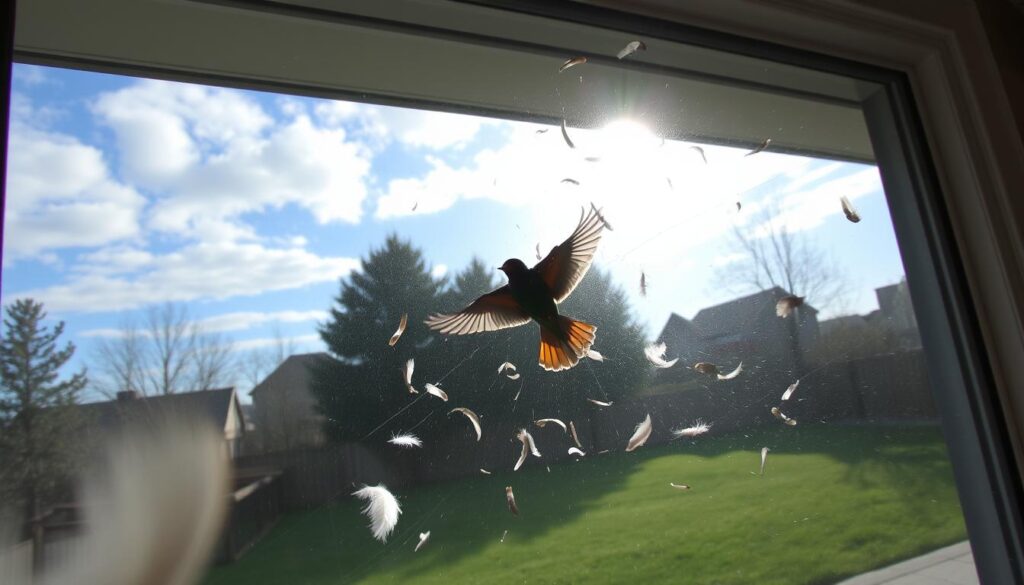Every year, up to 1 billion birds die in the United States because of window collisions. This is a huge problem for bird populations. As more windows are built, it’s important to understand why and how to stop these deaths.
Windows can look like open sky or greenery to birds, leading them to crash into them. Even if a bird flies away, it might still be hurt badly. Day and night, windows can be deadly for birds.
In this article, we’ll look at why birds hit windows, the injuries they suffer, and what it means spiritually and scientifically. We’ll also give tips on how to spot dangerous windows and prevent these accidents. Plus, we’ll tell you what to do if a bird hits your window.
Key Takeaways
- Up to 1 billion birds die annually in the U.S. due to window strikes, a staggering statistic.
- Windows can appear invisible or reflect vegetation, misleading birds and causing fatal collisions.
- Both daytime reflections and nighttime lighting contribute to the problem of bird-window collisions.
- Understanding the causes and implementing effective solutions is crucial for bird conservation.
- Proper response and evaluation by professionals are essential for injured birds’ recovery.
Understanding Bird-Window Collisions: A Growing Concern
Bird-window collisions are a big problem, with 365 million to 1 billion birds dying each year in the U.S. Glass windows look invisible or reflective to birds, causing confusion and harm. This affects many bird species, both common and rare.
The Scale of the Problem
This issue is widespread, with most incidents happening at homes and low-rise buildings. Only a tiny fraction of bird collisions involve skyscrapers. Even small structures like glass walkways and bus stop shelters play a big role in bird deaths.
Why Birds Can’t See Glass
Birds see the world differently than humans. Their body temperature is around 105 degrees Fahrenheit. This makes them think glass windows are open spaces, not barriers. This mistake can lead to serious injuries and death for birds.
Impact on Bird Populations
Bird-window collisions have a big impact on bird populations. They lead to the decline of many species, both common and rare. It’s important to understand this problem to find ways to protect birds and keep our ecosystems balanced.
“Between 365 million and 1 billion birds die from collisions with windows across the United States annually.”
The numbers are alarming, showing we need to act fast. By spreading the word and finding solutions, we can make bird-window collisions a thing of the past. This will help our bird friends live safely in their natural homes.
Common Types of Window Collisions Birds Experience
Bird strikes against windows are a big problem, causing millions of bird deaths each year. Birds crash into windows in two main ways: during the day and at night. In the daytime, birds hit windows because they see their own reflection or think the glass is air.
At night, birds that migrate are more likely to hit windows that are lit up. This is especially true in places with low ceilings or fog.
Some birds also attack their own reflections in windows, especially when they’re trying to protect their territory. This is called “window aggression” and can hurt or even kill the birds.
| Collision Type | Causes | Vulnerable Species |
|---|---|---|
| Daytime Collisions | Reflection of vegetation, inability to perceive glass | All bird species |
| Nighttime Collisions | Lighted windows, low-ceiling or foggy conditions | Nocturnal migrating birds |
| Window Aggression | Territorial behavior during breeding season | Birds with strong territorial instincts |
It’s important to know about the different ways birds hit windows. This helps us find ways to protect them better.
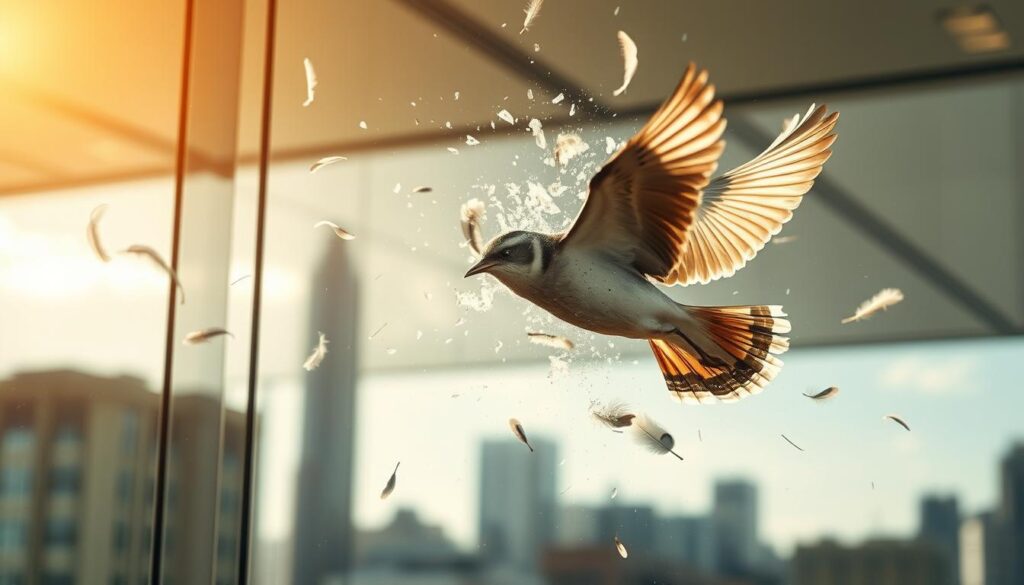
“Homes and other buildings one to three stories tall are estimated to cause about 253 million bird deaths annually due to collisions with glass.”
What Does It Mean When Birds Hit Your Window?
When birds hit windows, it can mean many things. This includes spiritual and cultural views, as well as scientific reasons. Understanding these views can give us a deeper look into these common events.
Spiritual and Cultural Interpretations
In some cultures, a bird hitting a window is seen as a sign of change. It might mean a new chapter in life, like a new job or relationship. People believe the bird’s death upon collision brings good luck or positive energy.
Scientific Explanations
From a scientific view, birds hit windows because they can’t see glass as solid. Their behavior, like defending territory or migrating, also plays a part. Sadly, at least half of the birds who hit windows die from their injuries or are killed by predators while stunned.
Behavioral Patterns
- Bird crashes can symbolize a reminder to listen to one’s intuition and pay attention to gut feelings.
- They may indicate an ending in one’s life, such as the conclusion of a job or relationship.
- Some believe a bird strike can be a sign from an angel or spiritual guide attempting to communicate.
It’s important to understand bird crashes with both science and cultural views. This way, we respect the many meanings behind these events.
| Spiritual and Cultural Interpretations | Scientific Explanations | Behavioral Patterns |
|---|---|---|
| Symbolize a new change in life, like a new job or relationship | Avian inability to perceive glass as a solid barrier | Reminder to listen to intuition and pay attention to gut feelings |
| Belief that bird’s death upon collision is symbolic of good luck | Territorial defense or migratory patterns contribute to collisions | Indication of an ending in one’s life, such as a job or relationship |
| Symbolize good, positive energy headed in one’s direction | At least half of collision victims die from injuries or predation | Sign from an angel or spiritual guide attempting to communicate |
“A bird crashing into a window can be a reminder to listen to intuition and make small but meaningful changes in life.”
Why Birds See Windows as Inviting Flying Spaces
Birds see the world differently than we do. Their eyes are made to spot movement fast. This helps them find food or avoid danger. But it also makes them think windows are open spaces to fly through.
Windows can reflect the sky and trees, making birds think they can fly right through. This mistake is a big reason why birds crash into windows. It’s a problem that affects many birds.
Every year, millions of birds hit buildings in the U.S. Many of these crashes happen at home windows. Knowing why birds do this is key to stopping it.
“Nearly 30% of the North American bird population has been lost since 1970 due to various factors, including window strikes.”
We can help birds by making windows less appealing. By understanding their vision, we can protect them from harm. This is the first step in saving bird lives and reducing window crashes.
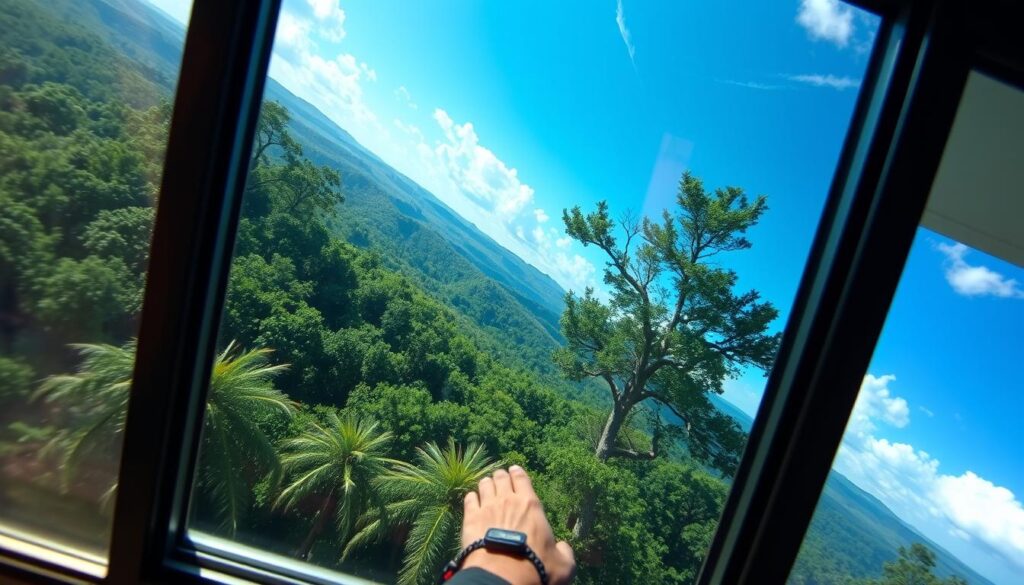
The Role of Light and Reflection in Bird Strikes
Bird-window collisions are a sad and common problem. Light pollution and reflections play a big part. During the day, windows can reflect the sky or plants, making birds think they can fly through. At night, city lights confuse birds on their way, making them crash into windows.
Daytime Collisions
Windows reflect more when they get brighter light. This makes birds think they can fly right through. Changing the light inside can help reduce these accidents.
Nocturnal Migration Issues
City lights are a big danger for birds flying at night. They get lost and crash into windows. Turning down the lights outside can help keep birds safe.
Seasonal Factors
More birds crash into windows during migration and breeding times. Migratory birds are more at risk. Knowing when it happens helps us protect them better.
“Bird–window collisions account for approximately one billion bird deaths annually in North America.”
By tackling light and reflection issues, we can help save birds. This is a big step towards reducing these tragic accidents.
Common Injuries Birds Suffer from Window Strikes
Colliding with a window can be very harmful for birds. They might get head trauma, broken jaws, eye damage, or even hurt bones needed for flying. This includes the coracoid or clavicle.
Even if birds fly away, they can still have serious internal injuries. They might have internal bleeding, bruising, or problems with their breathing. These can be very dangerous and need quick help.
Knowing the size of the window and why the bird hit it helps find the best safety steps. Birds need professional medical care for a full check-up and treatment. This is especially true for bird injuries and avian trauma from collision impacts.
| Injury Type | Potential Consequences | Treatment Needed |
|---|---|---|
| Head Trauma | Concussion, brain damage, skull fractures | Anti-inflammatories, pain medication, rehabilitation |
| Fractured Jaws | Difficulty eating, impaired feeding | Splinting, pain medication, soft food diet |
| Eye Injuries | Blindness, corneal ulcers, hemorrhaging | Medicated eye drops, antibiotic ointments |
| Bone Fractures | Impaired flight, inability to migrate | Splinting, pain medication, physical therapy |
Quick vet care is key for birds hit by windows. With the right help, many can heal and keep flying.

Identifying Dangerous Windows in Your Home
Preventing bird-window collisions starts with finding the problem areas in your home. Not all windows are equally risky for birds. Some types and locations are more likely to attract and trap birds, which can be deadly.
Risk Assessment Factors
Look at the size, placement, and surroundings of your windows to assess risks. Large picture windows, windows at right angles, and those near bird feeders are especially dangerous. Also, watch for reflections of branches, sky, or other features that might attract birds.
Problem Areas to Watch
- Large, expansive windows that create the illusion of a clear flying path
- Windows situated at corners or right angles, creating confusion for birds
- Windows near bird feeders, baths, or other attractants
- Windows with reflections of vegetation, sky, or other natural elements
Any windows near bird feeders are high-risk and should be made bird-friendly to prevent collision prevention. A detailed home assessment helps you find the most dangerous windows. Then, you can take steps to protect the birds in your area.
Effective Solutions to Prevent Bird Window Collisions
Bird-window collisions are a big problem, harming many birds. Luckily, there are ways to stop these accidents and protect our bird friends.
One easy and cheap way is to use tempera paint or soap on windows. This makes birds see the glass and avoid it. You can also use decals or tape to make a pattern on the window.
For a lasting fix, try Acopian BirdSavers or “zen curtains.” These have vertical cords or strings that stop birds from hitting the glass. Another good choice is one-way transparent films, like Collidescape, which birds can see but humans can’t.
In new buildings or when fixing old ones, think about using windows with screens or grilles. These add extra safety for birds. Inside, using vertical blinds can also help birds know the glass is there.
The goal is to make windows clear to birds but still good for people. By using these methods, we can help keep our bird friends safe and support their numbers.
| Solution | Description | Effectiveness |
|---|---|---|
| Tempera Paint or Soap | Applying a temporary visual barrier to windows | High |
| Decorative Decals or Tape | Creating a visible pattern on window surfaces | High |
| Acopian BirdSavers or “Zen Curtains” | Vertical cords or strings spaced 10-15 cm apart | High |
| One-way Transparent Films | Collidescape or similar products | High |
| External Screens or Grilles | Physical barriers added to windows | High |
| Interior Blinds or Curtains | Vertical blinds or curtains | Moderate |
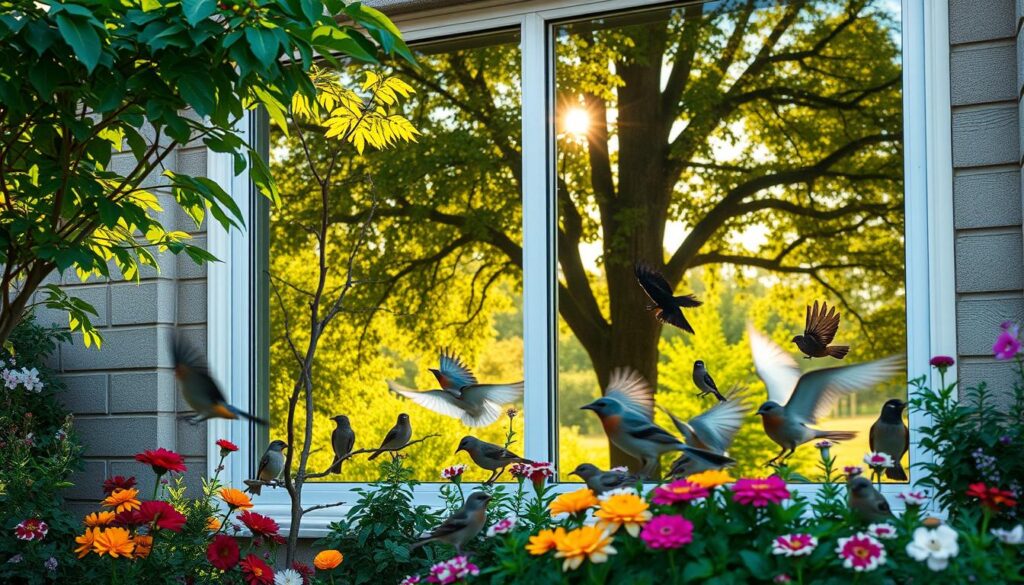
By using these solutions, we can greatly reduce bird-window collisions. This helps protect our bird friends and supports their numbers.
Professional Window Treatments for Bird Safety
More and more birds are hitting windows, leading to a search for solutions. Homeowners and businesses are looking at ways to make windows safer for birds. There are many options, from commercial products to DIY fixes, to help prevent bird deaths.
Commercial Solutions
Feather Friendly tape is a well-known product that makes windows visible to birds. Collidescape is another option. It’s a film that looks opaque from the outside but lets you see in.
DIY Options
- Using tempera paint, soap, or tape to make patterns on windows is a cheap DIY fix. Make sure the patterns are close together, about 2-4 inches, for best results.
- Acopian BirdSavers are vertical strings or paracord that can be bought or made at home. They’re a nice-looking way to stop birds from hitting windows.
Both commercial and DIY solutions aim to cover most of the glass. This makes windows clear to birds and lowers the chance of them hitting them. Professional setups last longer and look better, while DIY options save money and let you customize.
The main goal is to make windows safer for birds. This helps protect our feathered friends and supports their survival.
| Solution | Description | Effectiveness | Cost |
|---|---|---|---|
| Feather Friendly Tape | Adhesive tape that creates visible patterns on windows | High | Moderate |
| Collidescape Film | One-way transparent film that appears opaque from the outside | High | Moderate |
| Tempera Paint/Soap/Tape Patterns | DIY window markings spaced 2-4 inches apart | High | Low |
| Acopian BirdSavers | Vertical strings or paracord installed on windows | High | Moderate |
What to Do When a Bird Hits Your Window
Seeing a bird hit your window can be upsetting. But, it’s crucial to know how to act. The bird’s safety is the most important thing.
If a bird rescue situation happens, catch and hold the bird gently. Put it in a dark, quiet spot like a cardboard box. This helps the bird calm down and recover. Don’t touch the bird too much, and don’t feed or water it.
After you’ve safely caught the bird, call a wildlife rehabilitation center for advice. They can tell you the best collision response and if the bird needs medical help.
If you’re told to let the bird go, do it in a wooded area away from buildings. Watch if the bird can fly well after release. If it can’t, catch it again and get more help from a wildlife expert.
Remember, the bird’s health is key. By following the right bird rescue steps and getting help from wildlife experts, you can help the bird recover. This way, it can fly back to its natural home.
| Prevention Tip | Impact |
|---|---|
| Place feeders within 3 feet or further than 30 feet from windows | Birds are less likely to collide with windows |
| Use window decals or stickers spaced 2 inches apart horizontally and 4 inches apart vertically | Significantly reduces bird collisions |
| Install bug screens on windows | Reduces reflectivity and cushions impact |
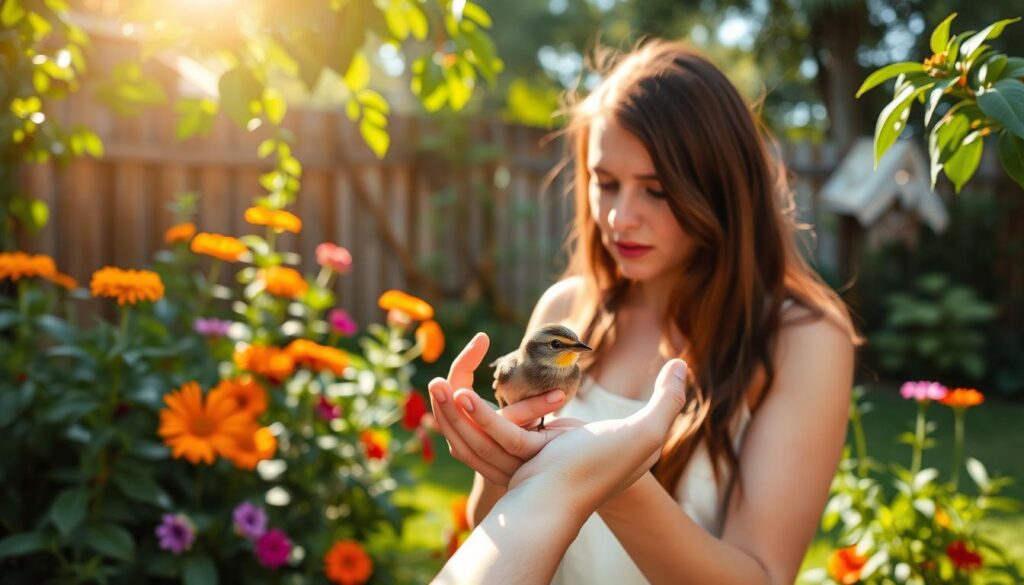
“Protecting birds from window collisions is an important step in conserving our feathered friends and maintaining healthy bird populations.”
The Impact of Urban Development on Bird Collisions
Urban areas are growing fast, affecting bird populations a lot. Glass buildings and more light pollution are big dangers, especially for birds migrating.
Research shows the problem is huge. Studies in 2014 found that building collisions kill hundreds of millions of birds yearly in the U.S. This reduces bird numbers by 2 to 9 percent. Over the last 50 years, bird numbers in North America have dropped by nearly 3 billion, or almost 30 percent.
Cities like Dallas, Houston, Philadelphia, and New York are fighting back. They have “Lights Out” programs to cut down on nighttime lights and bird collisions. Urban planners and architects are now designing buildings that are safer for birds. They use visible glass patterns and smart landscaping to help birds see buildings better.
| Key Statistics | Findings |
|---|---|
| Annual bird mortality in the U.S. from window collisions | Estimated between 365 – 988 million birds |
| Proportion of bird collision mortality by building type | 56% at low-rise buildings (4-11 stories), 44% at urban and rural residences, less than 1% at high-rises |
| Impact of bird/glass collisions on bird populations | Reduction of total bird numbers in North America by 2-9% over half a century |
The fight against bird collisions is key. It involves urban planning, light pollution, and bird conservation. By using smart solutions and spreading the word, we can live better with birds in our cities.
Understanding Bird Behavior Around Windows
Birds acting around windows is both fascinating and complex. Some species, especially during breeding season, attack their reflections in glass. This is seen in birds like cardinals, bluebirds, and robins, who fiercely protect their nests.
Migratory birds, however, are more likely to crash into windows. This is because they get confused by reflective surfaces and think they see open space. This confusion can be deadly for these birds.
It’s important to understand these behaviors to stop birds from hitting windows. Knowing why birds act this way helps us find better ways to protect them.
| Behavior Type | Examples | Seasonal Factors |
|---|---|---|
| Territorial Attacks | Cardinals, Bluebirds, Robins | More common during breeding season (March-June) |
| Migratory Collisions | Various migratory species | Increased during spring and fall migrations |
By understanding avian behavior around windows, we can make better plans to keep birds safe. This helps both territorial birds and migratory birds.
“A bird hitting a window is a sign of impending death” – This superstition is deeply rooted in various cultures around the world.
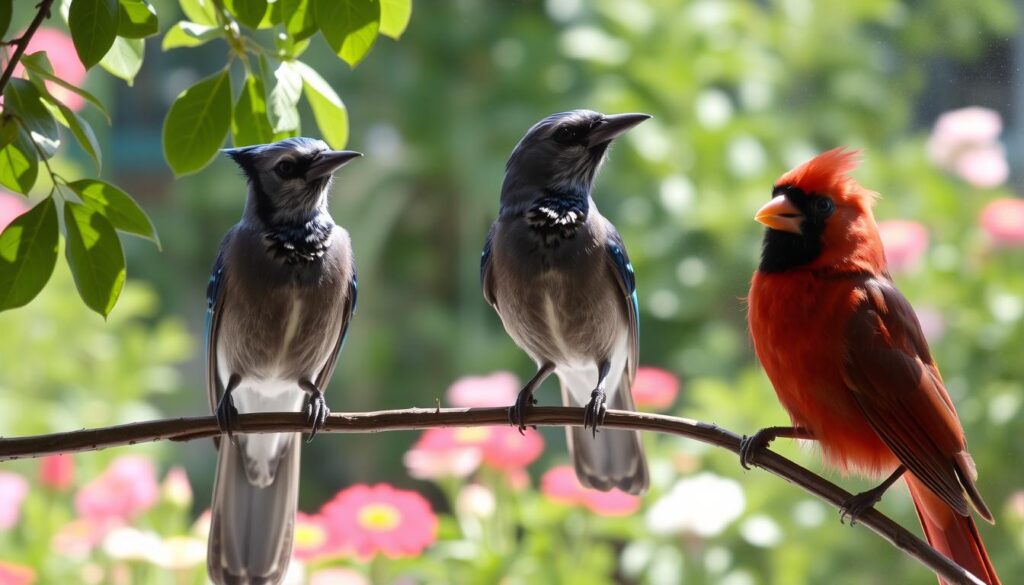
Conclusion
Stopping bird-window collisions needs a mix of understanding bird behavior, using effective prevention, and spreading the word. Both personal actions and big city plans are key to lowering bird deaths from window hits.
By making windows safer with different treatments and thinking about how our buildings affect wildlife, we help a lot. This helps birds and shows we care about the environment and keeping windows safe.
We must keep working to solve bird-window collision problems. We need to learn more about why it happens and find new ways to stop it. By teaching, pushing for change, and using known solutions, we can really help birds and keep our ecosystems healthy.
FAQ
What does it mean when birds hit your window?
Bird-window collisions are a big problem, with up to 1 billion birds dying each year in the U.S. Glass looks invisible or reflective to birds, causing them to crash. This affects many species and hurts some bird populations.
What are the common types of window collisions birds experience?
Birds crash into windows in two ways. During the day, they hit windows because they see reflections of plants or think they can see indoor plants. At night, birds hit lighted windows, especially in foggy or low-ceilinged areas.
How do birds perceive windows differently from humans?
Birds see windows as places to fly because of sky or plant reflections. Their vision is different from ours, making it hard for them to see glass as solid. Reflections can trick birds into thinking they are flying into open space.
What role do light and reflection play in bird strikes?
Light and reflection are key in bird strikes. Daytime crashes happen because of plant or sky reflections on windows. At night, artificial light in cities confuses birds during migration. Seasonal changes also affect crash rates, especially during migration and breeding.
What are the common injuries birds suffer from window strikes?
Window strikes can badly hurt birds, causing head trauma, jaw fractures, eye injuries, and damage to bones needed for flying. Even if birds seem okay after flying away, they might have internal bleeding or lung damage. Some injuries are not obvious but can be deadly.
How can I identify dangerous windows in my home?
Look for large picture windows, windows at right angles, and those near bird feeders. See your home from a bird’s view to spot reflections. Make windows near feeders bird-friendly, even if they’re far away.
What are the effective solutions to prevent bird-window collisions?
To stop bird crashes, use tempera paint or soap on windows, decals or tape, or Acopian BirdSavers. Mosquito screens or netting also work. Collidescape, a clear film, is another option. For new buildings, use screens on the outside, and use blinds inside.
What should I do if a bird hits my window?
If a bird hits your window, catch it gently in a dark, quiet spot. Don’t handle it too much and don’t feed or water it. Call a wildlife rehab for advice. If they say to release it, do so in a wooded area away from buildings. Watch if it can fly well after release.
How does urban development impact bird collisions?
Urban growth hurts bird collisions. More glass buildings and light pollution in cities are big threats, especially during migration. Cities have “Lights Out” programs to reduce light and help birds. Architects and planners are designing bird-friendly buildings to solve this problem.
